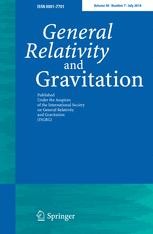GRG Editor's Choice: The collisional Penrose process
 Schnittman, J.D., The collisional Penrose process, Gen Relativ Gravit (2018) 50: 77. https://doi.org/10.1007/s10714-018-2373-5
Schnittman, J.D., The collisional Penrose process, Gen Relativ Gravit (2018) 50: 77. https://doi.org/10.1007/s10714-018-2373-5
Editor's Choice (Invited Review: State of the Field)
First Online: 05 June 2018
Part of the Topical Collection: "Testing the Kerr spacetime with gravitational-wave and electromagnetic observations"
"This is a very carefully written overview on the topic of energy extraction from spinning black holes, using Penrose-like mechanisms. The author added a couple of new calculations regarding the impact of Hawking and cosmological background radiation."
Abstract:
Shortly after the discovery of the Kerr metric in 1963, it was realized that a region existed outside of the black hole’s event horizon where no time-like observer could remain stationary. In 1969, Roger Penrose showed that particles within this ergosphere region could possess negative energy, as measured by an observer at infinity. When captured by the horizon, these negative energy particles essentially extract mass and angular momentum from the black hole. While the decay of a single particle within the ergosphere is not a particularly efficient means of energy extraction, the collision of multiple particles can reach arbitrarily high center-of-mass energy in the limit of extremal black hole spin. The resulting particles can escape with high efficiency, potentially serving as a probe of high-energy particle physics as well as general relativity. In this paper, we briefly review the history of the field and highlight a specific astrophysical application of the collisional Penrose process: the potential to enhance annihilation of dark matter particles in the vicinity of a supermassive black hole.
The author:
Jeremy D. Schnittman is Research Astrophysicist at the NASA Goddard Space Flight Center, Greenbelt, MD. His research interests include theoretical and computational modeling of black hole accretion flows, X-ray polarimetry, black hole binaries, gravitational wave sources, gravitational microlensing, planetary dynamics, resonance dynamics, and exoplanet atmospheres. He has been described as a "general-purpose astrophysics theorist," which he regards as quite a compliment.
GRG Editor's Choice:
In each volume of GRG, a few papers are marked as “Editor’s Choice”. The primary criteria is original, high quality research that is of wide interest within the community.
